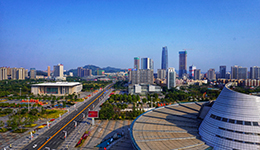
From “Made in Dongguan” to “Intelligently manufactured in Dongguan”
Dongguan is located in the south central part of Guangdong Province and to the east of the Pearl River Delta, Dongguan is in the heartland of the Guangdong-Hong Kong-Macao Greater Bay Area and Guangzhou-Shenzhen Science and Technology Innovation Corridor.Renowned for its “Made in Dongguan”, the city is a world manufacturing center and an important export base for China. Over the years, Dongguan has enjoyed close economic and trade ties with more than 200 countries and regions. With over 11,000 foreign-funded enterprises in Dongguan from over 50 countries or regions, which include nearly 100 projects by Fortune Global 500 companies, the city has attracted a total of 75 billion US dollars of foreign capital. Covering 30 specific sectors and 60,000 kinds of products, its over 150,000 industrial enterprises boast 90% being locally self-contained and thus constitute a complete manufacturing system, ranging from electronic information, clothing, furniture, hardware to molds, etc. Its smartphone industry is particularly well developed, with Huawei, Oppo, and Vivo mobile phone shipments ranking top six globally. One in five smartphones in the world is made in Dongguan. In recent years, Dongguan has been actively implementing the “Belt and Road” Initiative, having hosted for years the Guangdong 21st Century Maritime Silk Road International Expo, China Processing Trade Products Fair and Guangdong International Robot & Intelligent Equipment Exposition. It has launched the China Railway (CR) Express freight services that travel both between China and Europe and between China and Asia. With its integrated land and sea linkages, it strives to be an important hub for the “Belt and Road” Initiative.An innovation-oriented city dedicated to developing science and technology. The only prefecture-level city incorporated into the Guangzhou-Shenzhen Science and Technology Innovation Corridor, Dongguan has been, in recent years, carrying out its innovation-driven development strategy and promoting its “automation plan”, “growth doubling program” and a quick transition from “Made in Dongguan” to “Intelligently manufactured in Dongguan”.By 2017, its GDP increased by 8.1% to RMB 758.2 billion yuan, ranking 19th in China’s large and medium-sized cities and its total import and export reached 1.22 trillion, ranking fifth among peers. According to the jointly released report by the Chinese Academy of Social Sciences (CASS) and the UN-Habitat, Dongguan ranks 154th globally and 10th in China in terms of urban competitiveness.
The "Foreign Investment Law (Draft)" was announced
In order to further expand opening up, promote foreign investment and protect the legitimate rights and interests of foreign investment. On December 26, 2018, the "Foreign Investment Law (Draft)" was officially announced, and the foreign investment promotion mechanism was further established and improved. This article will list some of the main contents of the "Foreign Investment Law (Draft)":Investment Promotion:1. Except as otherwise provided by laws and administrative regulations, the state's policies supporting enterprise development are equally applicable to foreign-invested enterprises.2. In accordance with the needs of national economic and social development, the State adopts preferential measures to encourage and guide foreign investors to invest in specific industries, fields and regions.3. The State guarantees that Foreign-funded Enterprises participate in government procurement activities fairly. Government procurement is treated equally according to the products produced by foreign-invested enterprises in China.Investment Protection:1. The foreign investor's capital contribution, profits, capital gains, intellectual property rights, and compensation according to law may be freely transferred in RMB or foreign exchange according to law.2. The State protects the intellectual property rights of foreign investors and foreign-invested enterprises in accordance with the law, protects the legitimate, and encourages the implementation of technical cooperation on voluntary principles and business rules.
The White Paper for Foreign Investment Environment
In 2017, the actual use of foreign capital in various industries in the country reached US$136.32 billion, a year-on-year increase of 2%. Among them, the actual use of foreign capital in the non-financial sector was US$131.04 billion, ranking second in the world, and further improving the quality and level,play an important role for the national economy and social development.In 2017, 35,652 new Foreign-funded Enterprises were established nationwide, a substantial increase of 27.8% year-on-year, an increase of 22.8 percentage points over the previous year. In the past five years, the number of new non-financial Foreign-funded Enterprises in China has increased year by year. From 2013 to 2017, the number of new enterprises was 22,773, 23,778, 26,575, 27,900 and 35,652 respectively.Among them, in 2017, 4,986 new Foreign-funded Enterprises were established in the manufacturing industry, up 24.3% year-on-year; the actual use of foreign capital was US$33.51 billion, down 5.6% year-on-year, accounting for 25.8% of the national total. Among them, computer, communications and other electronic equipment manufacturing industry actually used foreign capital of 5.9 billion US dollars, an increase of 2.6%; electrical machinery and equipment manufacturing industry actually used foreign capital of 3.05 billion US dollars, an increase of 1.2%; general equipment manufacturing industry actually used foreign capital 2.89 billion US dollars. fell by 0.6% year-on-year. The above three industries accounted for 35.4% of the total foreign direct investment in the manufacturing industry.5,990 new Foreign-funded Enterprises in the high-tech service sector, up 81.9% year-on-year, actual use of foreign capital 260.7 billion dollars, an increase of 106.4%. Information services added 3,392 new enterprises, up 102.6% year-on-year, and actual use of foreign capital was US$20.97 billion, up 146.5% year-on-year. There were 32 new enterprises in e-commerce services, and the actual use of foreign capital was US$170 million, up 88.8% year-on-year. The actual use of foreign investment in R&D and design services was US$ 1.45 billion, up 3.2% year-on-year.In 2017, there were 1032 new Foreign-funded Enterprises in China's high-tech manufacturing sector, up 29.3% year-on-year, and actual use of foreign capital was US$9.89 billion, up 7.6% year-on-year. The actual use of foreign capital in the six branches of high-tech manufacturing increased year-on-year. Among them, the electronics and communication equipment manufacturing industry accounted for the largest foreign investment in high-tech manufacturing, accounting for 64.7%, reaching US$6.4 billion, up 4.5% year-on-year; Pharmaceutical Manufacturing Industry utilized foreign capital of 2.14 billion US dollars, up 1.8% year-on-year; medical equipment and instrumentation manufacturing industry utilized foreign capital of 870 million US dollars, up 23.1% year-on-year; computer and office equipment manufacturing industry utilized foreign investment of 370 million US dollars, up 65.7% year-on-year; aviation, spacecraft and equipment manufacturing industry experienced the fastest year-on-year growth, with foreign investment of US$80 million, up 110.2% year-on-year; information chemical manufacturing industry utilized US$0.4 billion, up 737.4% year-on-year, the largest increase.In 2017, the Chinese government substantially relaxed foreign investment access, increased the protection of foreign rights, improved the investment business environment, and encouraged foreign investors to continue to invest in China for a long time. The scale of foreign capital utilization was steadily increasing, and the quality and level were steadily improved.
Hebei Province speeds up the opening of coastal areas
Recently, the General Office of the Hebei Provincial Government issued the “Implementation Plan for Accelerating the Open Development of Coastal Areas”.Hebei Province will give play to the advantages of Qinhuangdao, Tangshan and Zhangzhou City, and take the initiative to dock the “Belt and Road” construction, and build a new pattern of port-based, urban-oriented and open-type industrial agglomeration. The expansion will improve the two growth poles of Caofeidian District and Bohai New District. And will create a first-class International Coastal Tourism Zone, to create a Modern Coastal Industrial Zone, and to create the first to develop innovative demonstration zone.Moreover, Hebei Province will improve the function of urban international exchanges, encourage Qinhuangdao, Tangshan and Cangzhou to actively undertake the International Cooperation Forum of local governments according to their own characteristics and opening up needs, and expand international cooperation channel. Enhance the vitality of urban innovation, give play to the synergy of Beijing-Tianjin-Hebei, and promote the construction of a deep-integrated regional science and technology innovation cooperation community to enhance the quality of urban development.In addition, Hebei Province will also optimize the business environment, insist to be equal for domestic and foreign investment, and establish a comprehensive “negative list” access system for domestic and foreign investment. And will create a high-quality policy environment, implement a unified examination and approval standards for domestic and foreign-funded enterprises, and also will implement the unified standards in terms of apply for foreign investment, project establishment, industrial and commercial registration, foreign exchange registration, business license processing, qualification licensing and government licensing, etc.
Innovation in Guangdong FTZ: new high ground of China’s opening-up
Roughly a thousand years ago, during the Song Dynasty (960–1279), Guangdong Province was among the first to promote international trade, leading China's opening-up without even realizing. Thanks to its favorable commercial policies and fair business environment, merchants and delegations from over 50 countries came to Guangdong to establish their businesses, making it one of the most remarkable trade centers of the old world.A millennium later, the coastal province has pushed its business boundaries even further, only this time, with its innovative free trade zone, the world can enjoy greater benefits from China’s surging economy and huge domestic market.Established in 2014, the Guangdong Free Trade Zone (FTZ) has been taking the lead in China’s opening-up to the world, serving as China’s test ground for deepening cooperation in the Guangdong- Hong Kong-Greater Bay Area, as well as an incubator for new systems and policies. As of September this year, a total of 250,000 new enterprises have settled in the FTZ, including 14,000 foreign-invested businesses. Over 270 Fortune 500 companies have established their business here, attracting over $ 17.4 billion in foreign investment.“China’s reform and opening-up has entered a deep-water zone, where tough challenges must be faced. The FTZ provides us a platform to explore new ways to solve problems that hinder the country’s development, invigorating the second boom of China’s opening up,” said Dong Feng, General Manager of Qianhai Mercantile Exchange (QME), an HKEX company in Guangdong FTZ.New land for China’s opening upLocated on the southern edge of Shenzhen, Qianhai Area, a former sleepy fishing village, is now one of three areas of the Guangdong FTZ. This thriving economic hub has attracted leading firms and start-ups from Hong Kong and Macao, thanks to its institutional innovation and other incentives including start-up incubators.As for its financial sector, Qianhai has rolled out over 70 innovative measures to support economic innovation, including the approval of the first batch of mainland asset managers to take part in the Qualified Domestic Investment Enterprises scheme. This scheme allows Chinese mainland investors to tap into a wider variety of foreign asset classes, while institutional innovations are introduced every three days, on average, to explore new possibilities in the open economy further.Such favorable conditions have attracted many financial giants, such as QME, to establish their business in Qianhai. Launched in October, QME, China’s testing bed for commodity trade, aims to build an efficient platform for China’s spot exchange, helping the country gain pricing power over bulk commodities.“Our mission is to reshape the landscape of China’s bulk commodity market, which is an unprecedented endeavor, for that we need institutional innovations and new policies, which Qianhai can offer,” said Dong.According to Dong, in order to promote China’s economic development, reform is required to shake up some deep-rooted structural problems, while Qianhai can provide a testing ground to help open China wider to the outside world.Echoing Dong, Eric-Kuo, co-founder of R-Guardian, a Hong Kong company in Qianhai featuring smart security technologies such as credit card shielding solutions, noted that Qianhai’s innovative measures to attract startups have transformed the area into a dream for young entrepreneurs like him.“Favorable policies such as assistance to connect with investors are especially attractive to start-ups from Hong Kong and Macao, as many of us have been struggling to find investors due to the high operational cost at home,” said the 27-year-old Hong Kong entrepreneur.To attract talents like Kuo, a university-like incubator was founded in Qianhai in 2014, providing young entrepreneurs one-year free rent, a favorable tax rate and assistance to connect with well-known angel investors and venture funds to those aged between 18-45. The center has so far helped 340 start-ups, 169 of which are from Hong Kong and Macao, while half of their projects have already obtained investment, worth a total of over 1.5 billion RMB (about $ 210 million).Institutional innovation has attracted foreign investment and talents to Qianhai. Moreover, successful projects have now also been introduced across the country. According to local authorities, Qianhai has so far produced 401 institutional innovation projects, with 28 spreading nationwide and 62 being rolled out in Guangdong Province.“As the frontline of China’s reform, Guangdong FTZ generated great rewards in the past. I believe the FTZ will serve as a pioneer for China’s further opening-up, benefiting both China and the world with its institutional innovation,” said Dong.The power of advanced technologiesIn addition to institutional innovation, new technologies have also become a major focus of Guangdong FTZ. Seventy-three kilometers away from Qianhai Area, Nansha New Area in Guangzhou serves as Guangdong FTZ’s tech hub. The palm-sheltered region boasts countless tech startups, many of which have become leading powers in their field thanks to the support of local authorities. Pony.ai, a self-driving car unicorn company based in Nansha New Area, has become a name card of Guangdong FTZ. The company has conducted countless road tests in Nansha New Area, constructing a reliable database that can help driverless cars adapt to China’s complicated road conditions and traffic.“Real road tests are crucial for driverless cars to retrieve valid data, which can help them cope with unexpected situations in the future. We would often report in advance to the government, asking for a specific area in the city to test our product, and the local authorities are cooperative and helpful,” said Cao Tiantian, the company’s business development manager, noting that the FTZ is a visionary when it comes to the development of new technologies.According to Cao, favorable policies including preferential tax rates and easier registration procedures for foreign talents have boosted the company’s development, allowing it to become a leading power in AI and driverless car technologies.“We are going to carry out a trial for a driverless car-hailing service by the end of 2018. This innovation could not have been realized without the help of the FTZ,” she added.VIPSHOP, an e-commerce company born and raised locally, also enjoys excellent benefits thanks to the local authorities’ support in high tech. According to Peng Xinguo, senior manager of VIPSHOP’s warehouse located in Nansha harbor, a new headquarter along with a warehouse equipped with full-automatic product lines is expected to be finished in Nansha New Area in 2019, with an investment of over one billion Yuan.“Faster logistics is the core competitiveness of any e-commerce company. Nansha’s advanced intelligent clearance system ensures greater time-efficiency and allows the customers to track every piece of information about their products online,” he said.According to Peng, with the company’s new automatic product line and the FTZ’s intelligent clearance system, the whole process from a product being imported to being in the hands of a customer only takes about three to six days.“Since the trial of cross-border e-commerce business started, VIPSHOP’s cross-border business has generated an annual revenue of over 8.24 billion yuan. With the help of modern technologies and the support of the FTZ, I believe this revenue will grow even more in the future,” added Peng. Source: en.people.cn
Belt, Road exporting China's know-how
The China-proposed Belt and Road Initiative is bringing the Asian country's infrastructure capital and knowhow to developing countries involved in its expansion, a renowned US scholar said."China has shown itself to be a vivid example of the benefits that can flow from the active hand of government in investment in infrastructural development," Sourabh Gupta, a senior fellow at the Washington-based Institute for China-America Studies, said in a recent interview."As the Belt and Road Initiative is extended and expanded overseas, it will afford a similar foundation on which developing countries can jump-start their own development on lines achieved by China over the past three decades," he said.Proposed by China in 2013, the BRI, which refers to the Silk Road Economic Belt and the 21st Century Maritime Silk Road, aims to build a trade and infrastructure network connecting Asia with Europe and Africa along the ancient trade routes of the Silk Road.Development under the initiative's transnational framework involves a variety of countries, and China has the finance, skills and experience to make infrastructure growth a reality, Gupta said.The key is early-stage investment in hard and soft infrastructure, he noted.While trade liberalization and market forces are important for resource allocation and growth, inclusive industrialization-led development "cannot be left to market forces alone," he said."The active hand of government is required to overcome a host of deficiencies related to institutional shortcomings, rent-seeking, and a general lack of competition," he said.It is also important to ensure that the infrastructural investments under the BRI banner are "well-designed and productivity-enhancing", given that these investments have long gestation periods, and the financing that is provided needs to be paid off from the productive assets created, said the expert."Creating long-term productive assets requires wise and patient capital - a difficult challenge, and this is the reason that there is such a vast global deficiency in infrastructure investment. So Chinese capital and know-how are very important to fill this gap," he said.The world's infrastructure spending is insufficient. For example, $5.5 trillion is needed between now and 2035 to fill the gap in global infrastructure spending, according to the McKinsey Global Institute."But for the gap to be filled efficiently, it also requires that the feasibility of projects is conducted with great due diligence and does not add to the creation of unproductive assets that could saddle countries with excess debt," Gupta said."In this regard, it is important to stock-take the achievements and progress under the BRI, so that the initiative can be rolled out even more effectively."Source: China Daily

Please leave us a message and we will get back to you shortly.

If you want to learn more information about investing in China, please leave your email address, we will send you the relevant information and article every month.
 0086-10-53270173
0086-10-53270173 china@tanikawa.com
china@tanikawa.com











